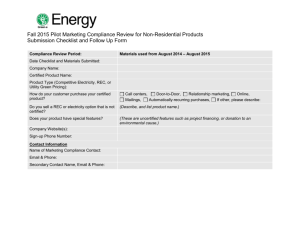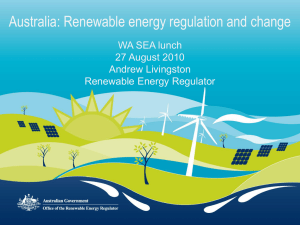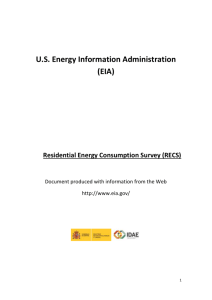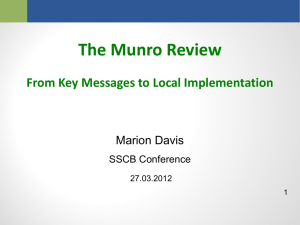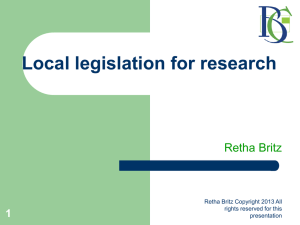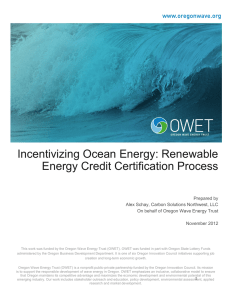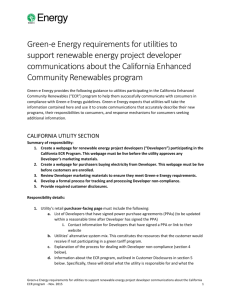Proposal from Green-e to minimize double counting - M-RETS
advertisement
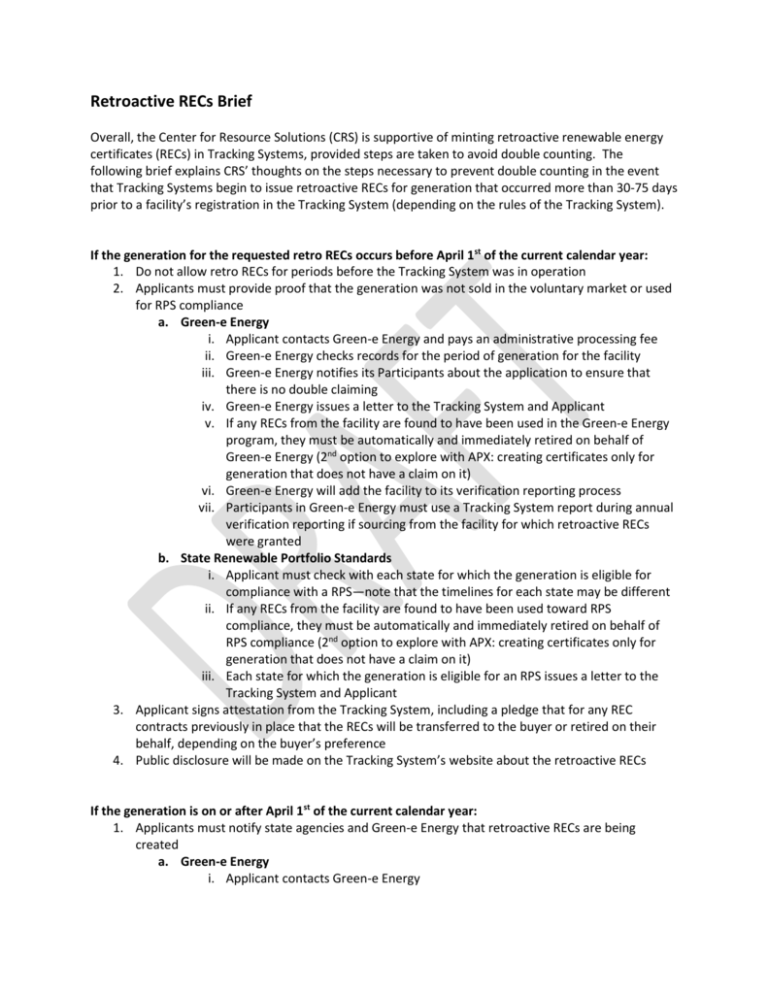
Retroactive RECs Brief Overall, the Center for Resource Solutions (CRS) is supportive of minting retroactive renewable energy certificates (RECs) in Tracking Systems, provided steps are taken to avoid double counting. The following brief explains CRS’ thoughts on the steps necessary to prevent double counting in the event that Tracking Systems begin to issue retroactive RECs for generation that occurred more than 30-75 days prior to a facility’s registration in the Tracking System (depending on the rules of the Tracking System). If the generation for the requested retro RECs occurs before April 1st of the current calendar year: 1. Do not allow retro RECs for periods before the Tracking System was in operation 2. Applicants must provide proof that the generation was not sold in the voluntary market or used for RPS compliance a. Green-e Energy i. Applicant contacts Green-e Energy and pays an administrative processing fee ii. Green-e Energy checks records for the period of generation for the facility iii. Green-e Energy notifies its Participants about the application to ensure that there is no double claiming iv. Green-e Energy issues a letter to the Tracking System and Applicant v. If any RECs from the facility are found to have been used in the Green-e Energy program, they must be automatically and immediately retired on behalf of Green-e Energy (2nd option to explore with APX: creating certificates only for generation that does not have a claim on it) vi. Green-e Energy will add the facility to its verification reporting process vii. Participants in Green-e Energy must use a Tracking System report during annual verification reporting if sourcing from the facility for which retroactive RECs were granted b. State Renewable Portfolio Standards i. Applicant must check with each state for which the generation is eligible for compliance with a RPS—note that the timelines for each state may be different ii. If any RECs from the facility are found to have been used toward RPS compliance, they must be automatically and immediately retired on behalf of RPS compliance (2nd option to explore with APX: creating certificates only for generation that does not have a claim on it) iii. Each state for which the generation is eligible for an RPS issues a letter to the Tracking System and Applicant 3. Applicant signs attestation from the Tracking System, including a pledge that for any REC contracts previously in place that the RECs will be transferred to the buyer or retired on their behalf, depending on the buyer’s preference 4. Public disclosure will be made on the Tracking System’s website about the retroactive RECs If the generation is on or after April 1st of the current calendar year: 1. Applicants must notify state agencies and Green-e Energy that retroactive RECs are being created a. Green-e Energy i. Applicant contacts Green-e Energy ii. Green-e Energy notifies its Participants about the application to ensure that there is no double claiming iii. Green-e Energy will add the facility to its verification reporting process iv. Participants in Green-e Energy must use a Tracking System report during annual verification reporting if sourcing from the facility for which retroactive RECs were granted b. State Renewable Portfolio Standards i. Applicant must check with each state for which the generation is eligible for compliance with a RPS—note that the timelines for each state may be different 2. Applicant signs attestation from the Tracking System, including a pledge that for any REC contracts previously in place that the RECs will be transferred to the buyer or retired on their behalf, depending on the buyer’s preference 3. Public disclosure will be made on the Tracking System’s website about the retroactive RECs General Verification Considerations to Prevent Double Counting: There is a danger in granting retro RECs to renewable MWh that have already been sold on paper. The crux of the issue is that in many cases there will be no oversight of the buyer of RECs from a generator, and therefore it will be difficult or impossible to ensure that the wholesale buyer is not double counting or double selling retro RECs once they are received. For example: Generator sells RECs on paper to Wholesaler. Wholesaler sells RECs on paper to Buyer 1. Time passes, and Generator received retro RECs for the RECs they have sold on paper to Wholesaler. Generator properly transfers the retro RECs through Tracking System to Wholesaler. Wholesaler transfers the retro RECs to Buyer 2. o At this point a double sale has been made. Buyer 1 shows that they have RECs on paper. Buyer 2 shows that they have RECs in their Tracking System account. o At this point there are double claims on the same MWh of renewable generation. Neither Buyer 1 nor Buyer 2 knows that the other is making a claim on the same RECs. Either Buyer 1 or Buyer 2 could have sold those RECs onto another buyer, perpetuating the error and double claim. To prevent such possibilities, retro RECs minted in the Tracking System should do one of the following: 1. Certificates for those MWh determined by Green-e Energy and/or state RPS administrators to have already been sold / used should be immediately retired upon minting (primary recommendation); or 2. Do not create certificates for MWh that that have been determined to have already been sold in a voluntary sale or used for RPS compliance (secondary recommendation, though this may be impossible in certain Tracking Systems) Cost for Green-e Energy Staff to Conduct Necessary Research: Proposed Pricing Structure per Facility per Applicant: CRS will charge $0.01/MWh for each facility per Applicant. There is a minimum fee of $200 per facility per calendar year of generation data from each Applicant. CRS is also supportive of Tracking System administrators charging Applicants cumulative annual fees based on the start date of the retro REC generation, so that generators do not intentionally defer registering in Tracking Systems to dodge the cost of generating and tracking multiple years of RECs. Timing of Research and Reporting of Results: CRS’ research will be based on verification data received annually from Green-e Energy participating sellers. Data on a particular calendar year of sales is received the following June. This, coupled with the fact that some generation is eligible for Certified sales in two years, affects the date on which CRS can provide fully-researched results. For generation to be researched that occurred on or before June 30 two years before the research Application is made, CRS should be able to conduct the necessary research and provide results within 60 days. For generation that occurred on or after July 1 two years prior to the Application up through June 30 of the year prior to the Application, research results for generation from those 12 months will not be available until September 1 of the current calendar year, or 60 days after the Application is received— whichever is later. For generation that occurred on or after July 1 of the previous year up through March 31 of the year of Application, research results for generation from those 12 months will not be available until September 1 of the following year at the earliest. For generation that occurred on or after April 1 of the year of Application, results will be available within 60 days after the Application is received. Example Reporting Timing if Application is Made in 2011: Generation Start Prior to June 30, 2009 July 1, 2009 Generation End June 30, 2009 June 30, 2010 July 1, 2010 April 1, 2011 March 31, 2011 December 31, 2011 Earliest Date Results Available 60 days after application received September 1, 2011 or 60 days after application received, whichever is later September 1, 2012 at earliest 60 days after application received
